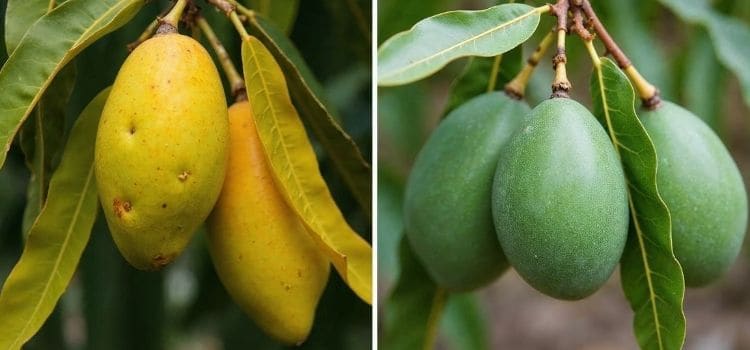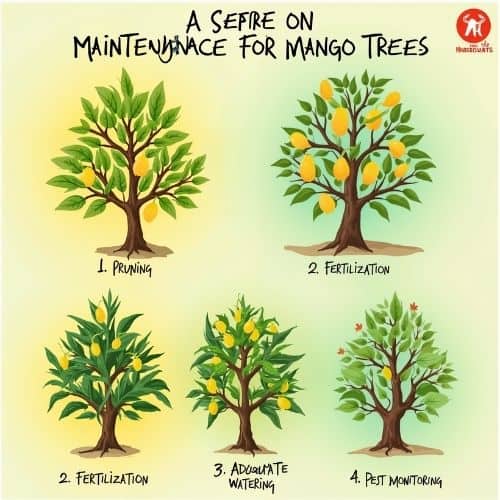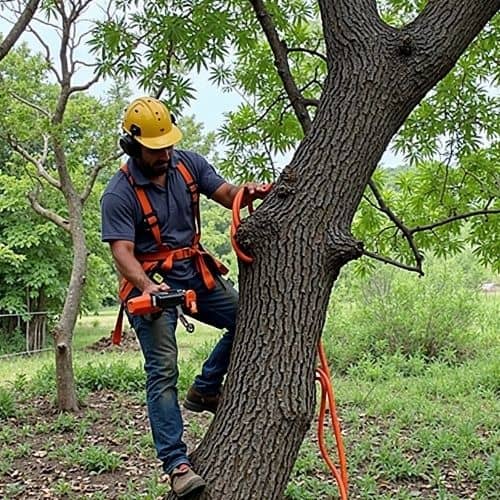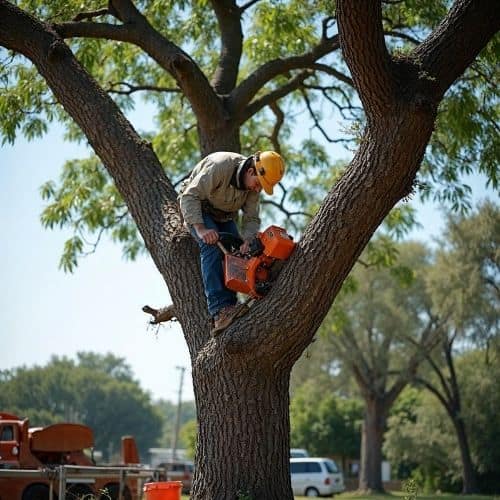Why Is My Mango Tree Not Green? Discover the Secrets to Vibrant Mango Tree Health!
Mango trees are a stunning addition to any garden, but what happens when their vibrant green fades away? Don’t worry; we’ve got the secrets to keeping your mango tree healthy and in tip-top shape! Whether you’re dealing with pesky dead branches or wondering about the right mango tree trimming techniques, we’re here to help. We’ll dive into why your mango tree isn’t as green as it should be and reveal how summer care for mango trees can make all the difference. Get ready to transform your garden into a lush paradise with our expert tips and tricks!

Understanding Mango Tree Health
Maintaining the health of your mango tree is crucial for its longevity and fruit production. Let’s explore common issues, the importance of regular maintenance, and signs that indicate your tree might be struggling.
Common Mango Tree Issues
Mango trees can face various challenges that affect their health and appearance. Nutrient deficiencies often manifest as yellowing leaves or stunted growth. Fungal diseases like anthracnose can cause black spots on leaves and fruit.
Pest infestations, particularly from mealybugs or scale insects, can weaken the tree and reduce its vigor. Environmental stressors such as extreme temperatures or improper watering can also lead to declining health.
Root rot, often caused by overwatering or poor drainage, is another serious issue that can cause the tree to lose its vibrant green color and overall vitality.
Importance of Mango Tree Maintenance
Regular maintenance is the cornerstone of mango tree health. Proper care ensures robust growth, abundant fruit production, and resistance to diseases and pests.
Consistent maintenance practices include:
-
Regular pruning to improve air circulation and sunlight penetration
-
Appropriate fertilization to meet nutrient requirements
-
Adequate watering tailored to seasonal needs
-
Pest and disease monitoring for early detection and treatment
By implementing these practices, you create an environment where your mango tree can thrive, maintaining its lush green appearance and producing high-quality fruit.
Signs of Unhealthy Mango Trees
Recognizing the signs of an unhealthy mango tree early can prevent minor issues from becoming major problems. Look out for these indicators:
-
Yellowing or browning leaves
-
Leaf drop outside of normal seasonal changes
-
Stunted growth or lack of new shoots
-
Bark damage or unusual growths
-
Poor fruit production or small, misshapen fruit
If you notice any of these signs, it’s crucial to investigate the cause promptly. Often, addressing the issue quickly can restore your tree’s health and prevent long-term damage.
Effective Mango Tree Trimming
Proper trimming is essential for maintaining the shape, size, and health of your mango tree. Let’s explore the benefits of regular pruning, effective techniques, and the best timing for this important task.
Benefits of Regular Pruning
Regular pruning is a vital aspect of mango tree maintenance that offers numerous benefits. It helps to shape the tree, promoting a strong structure that can support fruit weight and resist wind damage.
Pruning improves air circulation within the canopy, reducing the risk of fungal diseases. It also allows more sunlight to penetrate the tree, enhancing photosynthesis and fruit development.
By removing dead or diseased branches, pruning helps prevent the spread of infections and redirects the tree’s energy to healthy growth. This practice can also stimulate new growth and increase fruit production over time.
Techniques for Mango Tree Trimming
Effective mango tree trimming requires the right techniques to ensure the tree’s health and productivity. Here are some key approaches:
-
Remove dead, diseased, or crossing branches first.
-
Thin out dense areas to improve air circulation and light penetration.
-
Cut back long, leggy branches to encourage bushier growth.
-
Prune to maintain a desired shape and size, typically a vase or open-center form.
When making cuts, always use clean, sharp tools to prevent damage and disease transmission. Make cuts at a 45-degree angle just above a leaf node or lateral branch to promote healing and new growth.
Timing for Trimming Mango Trees
The timing of mango tree trimming is crucial for optimal results. Generally, the best time to prune is after harvest and before the next flowering cycle begins.
In most regions, this falls between late winter and early spring. Pruning at this time allows the tree to heal before the next growing season and doesn’t interfere with fruit production.
Avoid heavy pruning during the flowering or fruiting period, as this can reduce your harvest. However, light pruning to remove dead or diseased branches can be done year-round as needed.
Summer Care for Mango Trees
Summer presents unique challenges for mango trees. Understanding proper watering techniques, protection from sun damage, and nutrient requirements is crucial for maintaining tree health during hot months.
Watering Essentials in Summer
Proper watering is critical for mango trees during summer. These trees require consistent moisture but are susceptible to root rot if overwatered.
Water deeply and less frequently to encourage deep root growth. A good rule of thumb is to water when the top 2-3 inches of soil feel dry. Use a soaker hose or drip irrigation system to deliver water directly to the root zone.
During extreme heat, increase watering frequency but avoid waterlogging. Mulching around the tree base can help retain moisture and regulate soil temperature.
Protecting Trees from Sun Damage
While mango trees love sunlight, excessive heat can cause damage. Sunscald on trunks and branches can lead to bark cracking and pest infestations.
To protect your tree:
-
Whitewash the trunk and main branches with a mixture of water and white latex paint
-
Provide temporary shade for young trees using shade cloth
-
Maintain a full canopy through proper pruning to shade the trunk and branches
Regularly monitor your tree for signs of heat stress, such as wilting or leaf scorching, and adjust care accordingly.
Nutrient Requirements for Mango Trees
Mango trees have specific nutrient needs that change with the seasons. In summer, provide balanced nutrition to support fruit development and overall tree health.
Key nutrients include:
|
Nutrient |
Role |
Application |
|---|---|---|
|
Nitrogen |
Leaf growth |
Reduce in summer to avoid excessive vegetative growth |
|
Phosphorus |
Root and fruit development |
Apply before flowering |
|
Potassium |
Fruit quality and disease resistance |
Increase during fruit development |
Use a slow-release fertilizer formulated for fruit trees, applying it in small amounts throughout the growing season rather than one large application.
Impact of Dead Branches on Mango Trees
Dead branches can significantly affect the overall health and appearance of your mango tree. Identifying, removing, and preventing dead branches is crucial for maintaining a vibrant and productive tree.
Identifying Dead Branches
Recognizing dead branches early is essential for maintaining mango tree health. Look for these telltale signs:
-
Lack of leaves or buds when the rest of the tree is in leaf
-
Brittle, dry wood that snaps easily
-
Bark that’s peeling or missing
-
Discoloration or a grayish appearance compared to healthy branches
Regularly inspect your tree, especially after storms or during drought periods, as these conditions can lead to branch death.
Removing Dead Branches
Proper removal of dead branches is crucial to prevent further damage and promote healing. Follow these steps:
-
Use clean, sharp pruning tools appropriate for the branch size.
-
Make the cut just outside the branch collar (the swollen area where the branch meets the trunk).
-
For larger branches, use the three-cut method to prevent bark tearing.
-
Dispose of cut branches properly to prevent disease spread.
Always prioritize safety, and consider hiring a professional for large or high branches.
Effects on Overall Tree Health
Dead branches can have significant negative impacts on your mango tree’s health and productivity. They serve as entry points for pests and diseases, potentially spreading infections to healthy parts of the tree.
These branches also divert the tree’s energy from fruit production and new growth. By removing them promptly, you redirect resources to healthy areas, promoting vigorous growth and better fruit yield.
Additionally, dead branches can pose safety risks, especially during storms. Regular removal of dead wood helps maintain the tree’s structural integrity and aesthetic appeal.
Enhancing Mango Tree Vibrancy
A vibrant mango tree is not only visually appealing but also more likely to produce abundant, high-quality fruit. Let’s explore key factors that contribute to enhancing your tree’s overall health and appearance.
Soil Quality and Fertility
The foundation of a healthy mango tree lies in the soil. Optimal soil conditions promote strong root development, efficient nutrient uptake, and overall tree vigor.
Mango trees thrive in well-draining, slightly acidic soil with a pH between 5.5 and 7.5. Conduct regular soil tests to monitor pH levels and nutrient content. Amend the soil as needed with organic matter to improve structure and fertility.
Key soil management practices include:
-
Adding compost or well-rotted manure annually
-
Maintaining a 2-3 inch layer of organic mulch around the tree (keeping it away from the trunk)
-
Avoiding soil compaction by limiting foot traffic around the root zone
Pest Management Strategies
Effective pest management is crucial for maintaining mango tree health and vibrancy. A proactive approach can prevent infestations and minimize damage.
Implement these strategies:
-
Regular inspections to catch pest problems early
-
Encouraging beneficial insects that prey on common mango pests
-
Using physical barriers like sticky traps or netting when appropriate
-
Applying organic or chemical pesticides only when necessary and following label instructions carefully
Remember, a healthy tree is more resistant to pests. Focus on overall tree care to reduce the likelihood of severe infestations.
Encouraging New Growth
Stimulating new growth is essential for maintaining a lush, green appearance and ensuring continued fruit production. Here are some effective techniques:
-
Practice proper pruning to remove old, unproductive wood and stimulate new shoots
-
Apply a balanced fertilizer in early spring to support the growth flush
-
Ensure adequate watering, especially during dry periods
-
Consider foliar feeding with a dilute seaweed solution to boost growth and stress resistance
Monitor your tree’s response to these practices and adjust as needed. With consistent care and attention, your mango tree can maintain its vibrant green color and robust health year after year.



